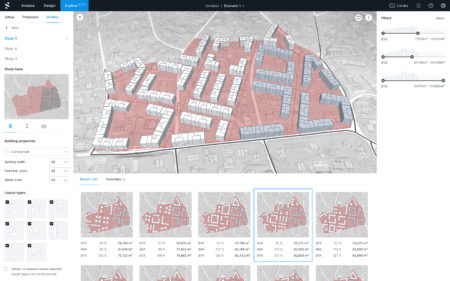Autodesk’s planned acquisition of Olso, Norway-based Spacemaker was some of the biggest news of the day in Day 1 of Autodesk University held this year not in Vegas but virtually across the world, due to the pandemic.
Why Spacemaker?
Today in a media-only event with Autodesk CEO Andrew Anagnost, the CEO of one of the world’s largest CAD companies stated that Spacemaker’s artificial intelligence (AI) technology was the world’s best as applied to this kind of early-stage design technology in AEC.
The Oslo, Norway-based software firm got its start about four years ago and today has 100 employees, presumably all in Oslo but they do have a Boston office. Amy Bunzel, Senior Vice President, AEC, and Design Solutions, Autodesk, told me that there is no intention of moving any employees from the Spacemaker team to the United States, but one goal Autodesk does have is expanding Spacemaker’s market beyond Europe.

An image of Spacemaker’s interface showing how the tool generates multiple iterations of schemes that pass various criteria set by the user, often an architect working for a large development company. (Image: Autodesk. All rights reserved.)
“Autodesk’s first goal with this acquisition is to help them scale to more customers,” says Bunzel. Well, Autodesk has plenty of customers to which to bring Spacemaker’s innovative AI-based technology.
The product is also 100 percent SaaS-based. “This will remain so as well,” Bunzel noted when I asked her if there were any plans to bring the technology directly into Autodesk tools. “This is a company that is doing SaaS right,” she replied, emphasizing that Autodesk’s long-term strategy is taking software technologies to the cloud.
Today during the special media-only event, Andrew Anagnost stated that Autodesk believes the future of software is in “apps” but apps connected to the cloud. In fact, in a previous discussion with Architosh over the Revit Open Letter, Anagnost clarified that some tools at Autodesk will be purely accessed through web browsers but many newer tools will be thick-clients like Autodesk Fusion 360. Today in the media-only event Anagnost admitted that he could see an app version of Spacemaker—meaning a version of it that doesn’t run in the web browser.

A view of Spacemaker’s user-interface, this one looking at the effects of noise on building design and parcel development decisions.
Spending resources on taking Spacemaker to a desktop app is very unlikely in the near future. In my call with Bunzel, she told me another goal for Autodesk with this purchase was to develop the offering so it becomes scalable for the average-sized firm, but only after Autodesk focuses on learning what their customers need so they can advance the too.
More for Developers
Spacemaker today has many clients from some of the biggest names in the world of AEC. Companies like Skanska and AF Gruppen are noted as users on the firm’s website. Bunzel noted that their primary clients are architects or similar professionals working inside large development companies. We intend to speak to the CEO of Spacemaker soon and will ask to elaborate on this.
One direction Autodesk may take Spacemaker is to focus on what things its architecture users may like to see inside Spacemaker that are not there today. Another goal is to do more with the integration of Revit, Autodesk’s BIM tool.
Architosh Analysis and Commentary
It will be interesting to see if Spacemaker could act as a gateway app for Autodesk in new markets like real estate. This could dovetail well with Autodesk’s digital twin aspirations. Autodesk’s Revit is increasingly getting generative design (AAD features) inside of Revit directly, rather than through Dynamo integration, (see, Architosh: “Generative Design in Review Powers Speed for Stamhis,” 24 Jun 2020) but Spacemaker is also doing generative design and with AI as an influence. Whose generative design is more powerful and impactful?
Revit’s generative design integration feels deeply related to its Project Fractal technology it showcased to the media at the AIA National Convention in Philadelphia a few years ago. It has the same UI/UX features as Project Fractal. This type of interface democratizes algorithms-aided design (AAD) making it accessible to average architects and design professionals. Even firms like Gensler are developing similarly bespoke and proprietary tools for their workflows so they can generate outcome-based design processes. (see, the latest issue of the Xpresso newsletter #21 here).



Reader Comments
[…] M1[24.06] Silicon: compatibilità di M1 con le app sul Mac[25.58] Clone digitale di Adelaide[34.31] Autodesk fa spesa[38.08] Residenza Carlo Erba a Milano[42.00] […]
Comments are closed.